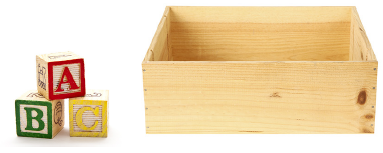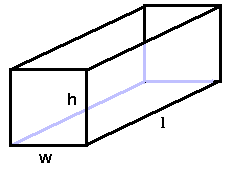This problem solving activity has a measurement focus.
Penny finds her old childhood building blocks. She wants a tidy box to store them in.

There are 100 2cm blocks and she needs to construct a rectangular cuboid in order to most easily fit the box into her wardrobe.
In her technology class, she saves costs by constructing an open wooden box using the least amount of wood.
What are the dimensions of her box that holds all 100 cubes?
- Find the volume and surface area of rectangular prisms.
- Devise and use problem solving strategies to explore situations mathematically (be systematic, draw a diagram).
The problem involves finding various possible dimensions of an open cuboid in order to minimise its surface area.
Students will need to be able to calculate the volume and surface area of a cuboid as well as present a systematic list of results in order to justify the minimum case. The use of three factors of 100 is also important. Consideration needs to be given to checking the various options of length, width and height that generate the least surface area of an open box. Recognising the values that should be the base dimensions (the biggest) in order to achieve the least surface area is helpful.
The Problem
Penny finds her old childhood building blocks. She wants a tidy box to store them in.
There are 100 2cm blocks and she needs to construct a rectangular cuboid in order to most easily fit the box into her wardrobe.
In her technology class, she saves costs by constructing an open wooden box using the least amount of wood.
What are the dimensions of her box that holds all 100 cubes?
Teaching Sequence
- Show the class the cubes and ask them to tell you what size container would be best to pack them in.
- Share ideas including: Smallest surface area? One you already have? Cheapest? Etc
- Ask how many different rectangular containers could be used to contain 12 cubes. (1 x 1, 12 x 1, 2 x 6, 1 x 3 x 4, 2 x 3 x 2)
- List the possibilities on the board. Discuss the volumes of each.
- Pose the problem for the students to solve.
- As the students work on the problem, ask questions that focus on the strategy that they are using to solve the problem:
What strategy are you using?
Is it getting you closer to a solution? How do you know?
Is there another strategy you could try? - Ensure you ask questions that probe the student’s understanding of volume and surface area:
How are you working out the volume?
Is the surface area related to the volume? How?
Do you have a "quick" method for working out the surface area? Can you explain it? - Share solutions.
Extension
- If Penny’s cubes have 3cm sides what is the surface area of the box that uses the least amount of wood?
- For 100 cubes of any common side length what will the surface area be of the box, that uses the least amount of wood?
Solution
Option 1
This problem can be solved directly using a table or the formula may be considered.
The volume of each cube is 2 x 2 x 2 = 8cm3. There are 100 cubes to be fitted into a cuboid shape. So the cuboid must hold 800 cm3.
Because the blocks have 2cm sides the dimensions of the cuboids must be even numbers. It may be easier to consider the number of 2cm cubes along each side then double the answers at the end. The number of cubes along each of the three sides must have a product of 100.
There are numerous possibilities but we are looking for the least surface area associated with this. Hence we choose the 20 x 20 side in the first row of the table to be on the base of the cube, rather than on four of the sides.
No. of cubes on each side l x w x h | Dimensions of the cuboid box | Surface Area of the cuboid box. cm2 |
10 x 10 x 1 | 20 x 20 x 2 | 400 + 4 x 40 = 560 |
20 x 5 x 1 | 40 x 10 x 2 | 400 + 2(80 + 20) = 600 |
25 x 4 x 1 | 50 x 8 x 2 | 400 + 2(100 + 16) = 632 |
50 x 2 x´ 1 | 100 x 4 x 2 | 400 + 2(100 + 8) = 616 |
10 x 5 x 2 | 20 x 10 x 4 | 200 + 2(40 + 80) = 440 |
25 x 2 x 2 | 50 x 4 x 4 | 3 x 200 + 2 x 16 = 632 |
5 x 5 x 4 | 10 x 10 x 8 | 100 + 4 x 80 = 420 |
Conclusion: So Penny should make the wooden box 10 cm long, 10 cm side and 8 cm high. This gives a minimum surface area of 420 cm2.

Option 2
Some students may go directly to the formula for Surface Area
Surface area = wl + 2 hw + 2hl
= wl + 2 h (w + l)
and this can be used in a spreadsheet to easily generate the Surface Area.
Solution to the Extension
From the first part of the problem we know the optimum number of blocks on each side.
| length = 5 blocks | giving dimensions | 5 x 3 = 15 cm |
| width = 5 blocks | 5 x 3 = 15 cm | |
| height = 4 blocks | 4 x 3 = 12 cm |
So the least amount of wood is
A = wl + 2h(w + l)
A = 15 x 15 + 2 x 12 (15 +15)
A = 225 + 24(30)
A = 225 + 720
A = 945This question should help students recognise the connection between the side length of the block and the total surface area enabling them to generalise.
They may need to consider 4cm and 8cm blocks to clearly identify this.
- For 100 blocks side length n the dimensions of the open box are 5n x 5n x 4n giving a surface area of,
A = wl + 2h(w +l)
A = 5n x 5n + 2 x 4n(5n +5n)
A = 25n2 + 2(20n2 + 20n2)
A = 25n2 + 40n2 + 40n2
A = 105n2